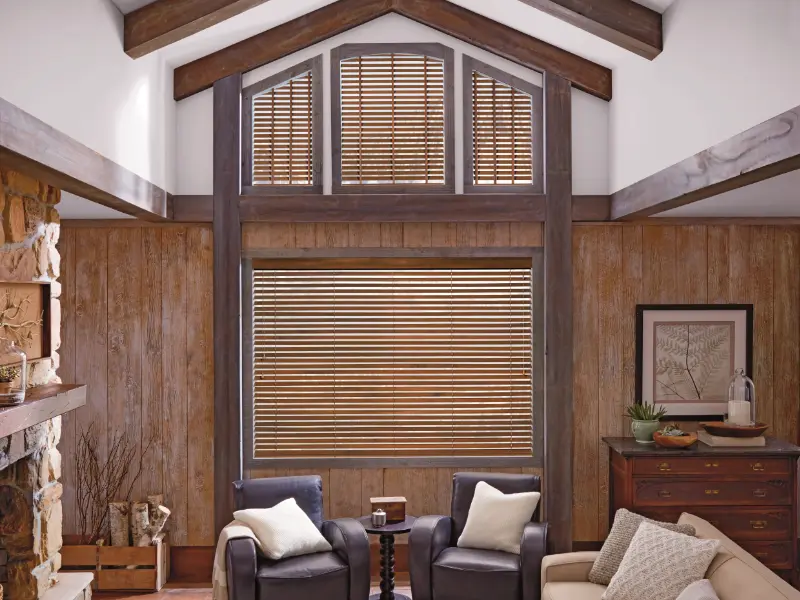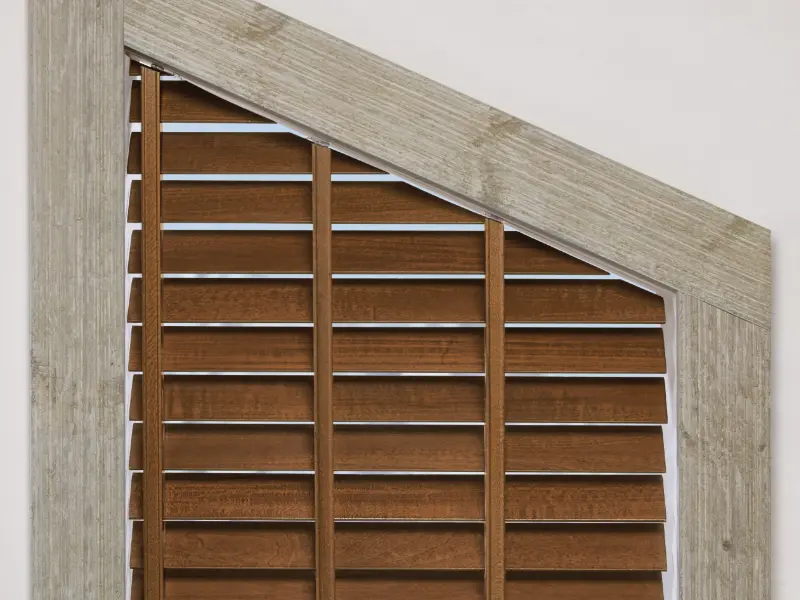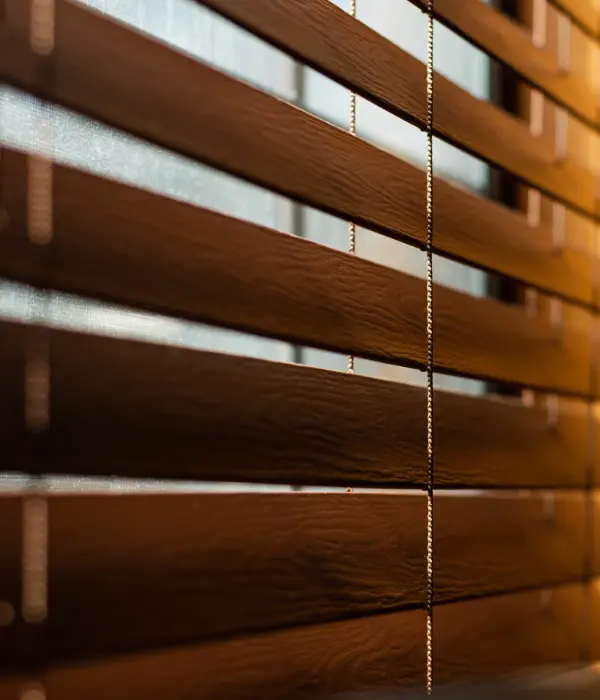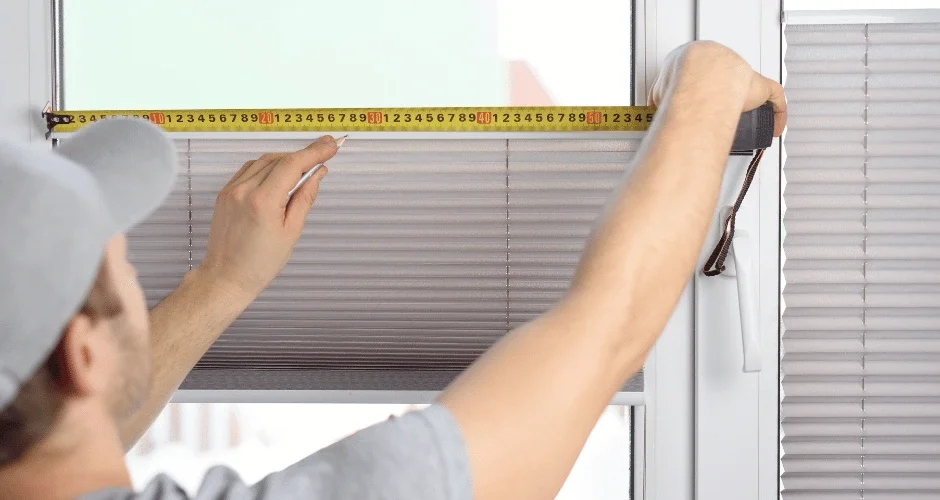Custom Wood Blinds
Wood blinds are a popular alternative to shutters. They’re cheaper, easier to install, and versatile enough to fit most window sizes and shapes.
Wood is a better insulator than vinyl or metal. Plus, it lends a look of natural warmth to a room.
Basswood and Ramin are the most common wood types used, but you can order your blinds in pine, oak, cherry, and more.

Why Choose Custom Wood Blinds?
- Aesthetics: Wood blinds have a natural, warm, and elegant appearance that complements interior styles from traditional to contemporary.
- Texture and Grain: The visible grain of wood creates depth and a visually appealing focal point in a room.
- Versatility: Wood blinds can be stained or painted in any color to match or contrast your decor.
- Durability: Quality wood blinds, especially those made from hardwoods like basswood or oak, can withstand daily use and exposure to sunlight without losing their appeal.
- Insulation: Wood is a natural insulator, helping regulate a room’s temperature.
- Sound Absorption: Wood blinds absorb sound far better than vinyl or metal, creating a quieter indoor environment.
- Environmentally Friendly: Wood blinds can be eco-friendly when made from responsibly sourced wood.
- Customization: Wood blinds can fit different window sizes and shapes, making them suitable for various window configurations.

Our Wood Blinds Gallery




Common Wood Types for Blinds
- Basswood blinds have fine and even grain, straight, parallel grain lines that run the length of the wood, a smooth texture, and a naturally light color. The wood is lightweight but strong and durable.
- Ramin blinds are made from the Ramin tree, which is fast-growing and abundant. It has a pale color, straight grain, and smooth texture and weighs slightly more than basswood.
- Oak blinds are known for their rich, grainy appearance. Oak is a highly durable luxury wood heavier than basswood or Ramin.
- Pine blinds have several variations, including eastern white pine, southern yellow pine, and ponderosa. They have a rustic appeal and work well in cabins or country-style homes.
- Cherry blinds have a natural reddish-brown color with a distinct grain pattern. They’re favored for their rich, elegant look.
- Cedar blinds offer natural insect and moisture resistance. Their aromatic qualities can repel pests.
- Maple blinds feature a light, uniform grain pattern. They’re known for their durability and suitability for staining or painting.
- Alder blinds have a light brown color and straight grain. They’re affordable and versatile.
- Faux wood blinds made from PVC or composite materials mimic natural wood but are cheaper and moisture resistant, making them suitable for high-humidity areas like bathrooms and kitchens.

Customizing Your Wood Blinds
The options are virtually limitless! Here are just a few:
- Type of Wood: Each offers a unique look and feel, from basswood to pine to cherry.
- Paint or Stain: Staining enhances the natural wood grain, while painting gives you a range of color options. Choose the level of sheen, from matte to glossy.
- Slat Width: Thicker slats have a more traditional look, while thinner ones appear more modern.
- Valance Style: Valances are decorative pieces that cover the top rail of the blinds. Styles include traditional, contemporary, and custom.
- Tape or Cords: Customize the lift cords or ladder tapes that hold the slats together. Choose from various colors and materials, such as fabric tapes, leather cords, or contrasting colors, to create a striking visual effect.
- Cordless and Safety Features: Cordless options eliminate a potential hazard for toddlers or pets.
- Motorization: Motorized blinds can be controlled with a remote, smartphone app, or voice commands, allowing you to adjust them without manual operation.
- Top Down/Bottom Up: A top-down/bottom-up feature lets you lower the blinds from the top or raise them from the bottom, giving you more control over privacy and light.
Confused by all the options? Don’t be. Talk to us about your needs and wants, or even better, visit our Los Angeles showroom to see and test the types and styles of blinds we can install in your home or office.

Installation & Follow-up: What to Expect
- Our sales staff will make an appointment to install your window treatments.
- We’ll install your window treatments to the highest standards and show you how to operate and maintain them.
- We view our relationship with you as permanent. If ever you experience a problem with our products, we’ll do our utmost to repair them.

Why Choose Aero Shade?
- We specialize in window treatments and can deliver the best possible results for your home or office.
- We've been in business since 1947.
- We're family-owned and 100% committed to customer satisfaction.
- Our window treatments for luxury homes have been featured in lifestyle and design magazines.
- We've installed blinds and shades for USC, UCLA, the Long Beach and Los Angeles Unified School Districts, and several Fortune 500 corporations.
- Our prices are reasonable. All estimates are free.
- We're an authorized dealer of the high-quality Hunter Douglas and Lutron brands.
- Our customer relationship continues after the installation. If you ever have a problem with an Aero Shade window treatment, we'll do our best to fix it.